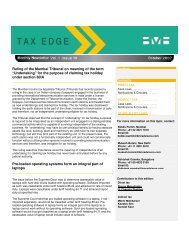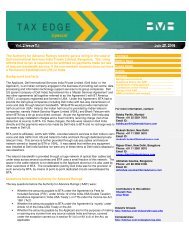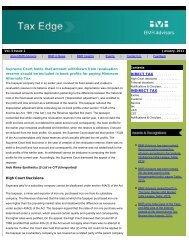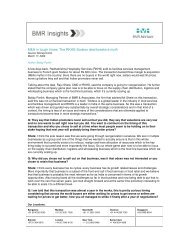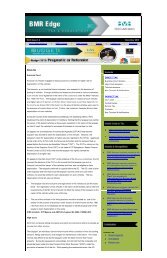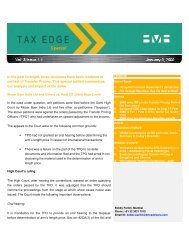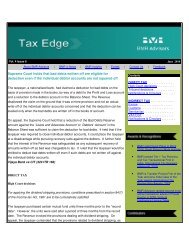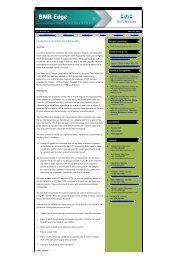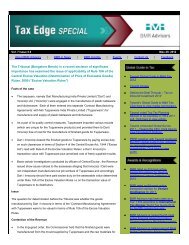Corporate Tax 2010 - BMR Advisors
Corporate Tax 2010 - BMR Advisors
Corporate Tax 2010 - BMR Advisors
Create successful ePaper yourself
Turn your PDF publications into a flip-book with our unique Google optimized e-Paper software.
Cravath, Swaine & Moore LLP<br />
USA<br />
above do not apply to corporations with debt to equity ratios of less<br />
than 1.5 to 1. The limitations on corporate acquisition indebtedness<br />
described above do not apply to corporations with debt to equity<br />
ratios of less than 2 to 1.<br />
3.6 Would any such “thin capitalisation” rules extend to debt<br />
advanced by a third party but guaranteed by a parent<br />
company<br />
If a foreign parent guarantees third-party debt of a thinly capitalised<br />
U.S. subsidiary, the IRS may assert that in substance the loan was<br />
actually made to the foreign parent and that the foreign parent<br />
advanced the funds to its U.S. subsidiary as an equity contribution.<br />
In this situation, any payments by the U.S. subsidiary to the thirdparty<br />
lender would be recharacterised as dividends to the foreign<br />
parent. Additionally, a guarantee by a foreign parent may trigger<br />
application of the earnings stripping rules discussed in question 3.4<br />
even though the lender is unrelated to the U.S. subsidiary.<br />
3.7 Are there any restrictions on tax relief for interest<br />
payments by a local company to a non-resident in addition<br />
to any thin capitalisation rules mentioned in questions<br />
3.4-3.6 above<br />
Other than the restrictions on the portfolio interest exemption<br />
discussed in question 3.3, there generally are no other restrictions<br />
on tax relief for interest payments by a local company to a nonresident.<br />
3.8 Does the United States have transfer pricing rules<br />
Yes. U.S. transfer pricing rules allow the IRS to apportion income,<br />
deductions, credits, or allowances from cross-border transactions<br />
among related entities if it determines that such apportionment is<br />
necessary in order to prevent evasion of taxes or to reflect income<br />
clearly. These rules may apply to transfers of services, tangible<br />
property or intangible property. Large multinational companies<br />
with significant operations in the U.S. often engage experts to<br />
review their transfer price arrangements to ensure compliance with<br />
U.S. law.<br />
4.3 What is the tax base for that tax (profits pursuant to<br />
commercial accounts subject to adjustments; other tax<br />
base)<br />
The United States has a parallel but separate system of tax<br />
accounting for determining a corporation’s tax base that is distinct<br />
from other regimes that may apply for commercial, financial or<br />
statutory purposes. This system is set out in the Internal Revenue<br />
Code. Under this system, a corporation must first calculate its gross<br />
income, which includes income from services, sales of inventory<br />
(minus cost of goods sold), dividends, royalties, interest, rent and<br />
other income. Gross income also includes capital gains from sales<br />
of property. From gross income, a corporation computes its taxable<br />
income by subtracting various deductions for costs incurred in its<br />
business such as wages, depreciation, rents, interest and other<br />
ordinary and necessary business expenses.<br />
4.4 If it otherwise differs from the profit shown in commercial<br />
accounts, what are the main other differences<br />
Although United States generally accepted accounting principles,<br />
referred to as GAAP, and tax accounting are similar in many respects,<br />
they differ in a few important ways. GAAP generally polices a<br />
reporting company’s incentive to accelerate revenue and defer<br />
expenses, while tax accounting polices a company’s incentive to defer<br />
income and accelerate expenses. In many cases, differences between<br />
the two systems can be traced to these competing biases.<br />
GAAP and tax accounting differ, for example, in the treatment of<br />
prepaid or contingent income and expenses. Under GAAP, income<br />
is recognised over the period to which it relates, and if a payment is<br />
received before it is earned it is held in suspense as deferred<br />
revenue. For tax purposes, income is generally recognised upon the<br />
earlier of the date of receipt or the date on which it is earned.<br />
GAAP recognises expenses in the period to which such expenses<br />
are economically attributable and often provides for the recognition<br />
of unpaid estimated expenses through reserves. By contrast, for tax<br />
purposes business expenses cannot be deducted until the amount<br />
can be determined with reasonable accuracy, all events have<br />
occurred that fix the fact of the liability and economic performance<br />
has occurred. As a result, reserves for estimated expenses are<br />
generally not deductible in computing taxable income.<br />
USA<br />
4 <strong>Tax</strong> on Business Operations: General<br />
4.1 What is the headline rate of tax on corporate profits<br />
The top federal tax rate for corporations is 35%. Most states and<br />
some local governments also impose income or similar taxes on<br />
corporate earnings.<br />
4.2 When is that tax generally payable<br />
A corporation’s tax year must match the annual period it uses for its<br />
commercial books and records, which can either be a calendar year<br />
or a fiscal year. Estimated tax payments are due quarterly. A<br />
corporation’s final tax return and the payment of its remaining tax<br />
liability is due on the 15th day of the 3rd month after the end of its<br />
tax year (March 15 for a calendar year corporation), although a 6-<br />
month extension is available with interest on any unpaid tax<br />
liability.<br />
ICLG TO: CORPORATE TAX <strong>2010</strong><br />
© Published and reproduced with kind permission by Global Legal Group Ltd, London<br />
4.5 Are there any tax grouping rules Do these allow for relief<br />
in the United States for losses of overseas subsidiaries<br />
Yes. In the United States, corporate members of an “affiliated group”<br />
may, and almost always do, elect to file a consolidated Federal income<br />
tax return. An affiliated group is one or more chains of U.S.<br />
corporations where a common parent corporation owns at least 80%<br />
of the stock (by vote and value) of another “includible corporation”,<br />
and one or more “includible corporations” (including the common<br />
parent) own at least 80% of the stock of the next lower tier of<br />
“includible corporations”. Generally speaking, the consolidated<br />
return regime taxes affiliated corporations as if they were a single<br />
taxpayer with respect to transactions with third parties. This provides<br />
affiliated groups with the benefit of being able to use losses from one<br />
affiliate to offset the income of another affiliate. Income and losses on<br />
transactions between affiliates, however, are generally deferred under<br />
complex rules until realised in a transaction outside of the group.<br />
Non-U.S. companies, tax-exempt corporations, and certain other<br />
companies are not includible corporations, so they may not be<br />
members of an affiliated group. Nevertheless, in certain<br />
circumstances the U.S. owner of a non-U.S. company may elect to<br />
treat that company as a pass-through entity for U.S. tax purposes.<br />
WWW.ICLG.CO.UK 267







